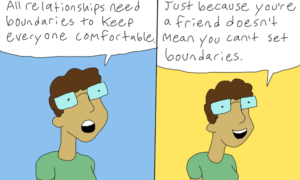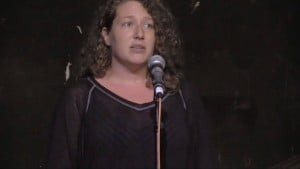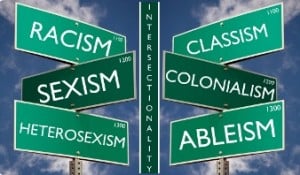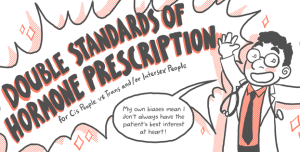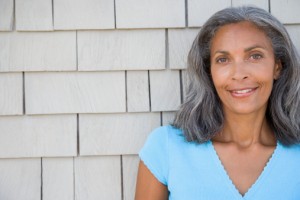
Source: Getty Images
Originally published on Adios Barbie and cross-posted here with their permission.
Courtesy of genetics, my hair started graying in my late teens.
At that point, I had already been initiated into the world of coloring my hair. At 14, I experimented with Sun-In that transformed my bangs brassy orange. Then, I used facial bleach to whiten a thick strip of my shoulder-length hair along one side of my face.
Soon after came L’Oréal in various shades of red, burgundy, and violet, and then an extended period when I used only black vegetable dyes. As a teenager, I colored my hair to have fun. To be cool. To experiment with different looks. To discover my own style.
Today, I dye my hair for one reason and one reason only: to cover the gray. My Irish grandmother also started graying in her teens. She had two funky white stripes that started at her temples and flared back like The Bride of Frankenstein.
She was pure white by 25.
I have to admit that around 19 years old, I felt short-changed when I noticed fresh sprouts of gray hairs. They did not congregate together to paint a gorgeous streak of white like Grandma’s had. No, instead the unruly hairs peppered themselves throughout my hairline, refusing to adhere to any sort of pattern. I wasn’t going to look funky. I’d just look old.
I felt as if I’d had no choice but to commit to a lifetime of coloring.
At 41, I have a substantial amount of white and gray hair that, when I allow it to grow in, contrasts greatly against my chestnut-mahogany hair. I’m unsure of how much gray I really have.
The thing is: The longest I’ve gone without dyeing my hair was for six months about a year and a half ago. When I reached half a year dye-free, I shamefully crumbled to the pressure to conform and covered the couple inches of virgin hair. It’s been just over two months since I last disguised my roots.
I am tired of dyeing of my hair.
I resent that every six weeks I have to either do it myself or visit my hairdresser. I would love to see how my long wavy hair would look in its natural salt-and-pepper state.
But I struggle with making the commitment to go color-free. I want to challenge myself to see beyond what society says is attractive. But I recognize that my perception of how I look is skewed because of the repetitive messages that “gray hair on a woman equals old and ugly.”
When I decided to stop coloring my hair for those six months, I readily took on the self-imposed challenge to accept my aging hair. I didn’t realize what a body image hurdle it would be. I had good days and bad days. I spent time a fair amount of time examining my hair and how its new lighter shades looked against my pale skin.
I tried erasing what I had been instructed to believe and see how it could be pleasing to look at. Even pretty. On good days, I was more accepting of my new silvery strands sprinkled throughout my roots, strongest around my face.
I would get excited – and impatient – when imagining what my hair would look like in a year to 18 months. Thick white roots on each temple remained hidden under my bangs. Secretly, I hoped that in time the pure white growth underneath would streak the part I showed to the world.
On bad days, the external pressures to follow the female hair norm clouded my vision and extinguished any positive thoughts I had of my authentic hair. The number of unsolicited opinions and conclusions about my decision to go natural astounded me.
Some insisted I was a rebel making a political statement. Others promised I would hook horrible.
“Women with long gray hair look like hags.”
“You’ll have to cut your hair short.”
“Don’t do it, Sharon, you’ll look so old.”
My assertions that beauty is a matter of perception didn’t do much to change their minds. Their arguments wore away at my resolve. If I presented the world with my natural hair, I would unequivocally be considered unattractive.
Admittedly, I also sought out opinions.
My closest friends wanted to be supportive, but most would try to hide their grimace and say something like, “Really? But I love your brown hair.” I wish I could say thanks.
My brown hair no longer exists. The brown hair people love so much is courtesy of Clairol. My husband – well – he’s dead-set against it.
I thought perhaps he would be supportive, especially because my size makes no difference to him. He vehemently doesn’t want me to get Botox or any type of cosmetic intervention. But it seems that he draws the line at hair color. More than one argument has ensued over the dilemma to dye or not to dye.
But I haven’t abandoned the idea of showing off my true hair color, whatever that may be.
These days, whether I’m walking or on public transport, I regularly scan the stream of faces – men and women alike – for white and gray crowns. Many more men display their natural silver streaks and white patches than women.
I try to imagine what the elderly women with their dyed, coiffed hair would look like with their natural tresses. I do the same for my almost-90-year-old Italian grandmother who still faithfully dyes her hair every six weeks.
But for those women who I’ve seen revealing their natural locks, I’m pleased to say that I can see the beauty in their hair.
What’s more, I admire it.
I hope that when I give up coloring once and for all I’ll be able to view myself — and my hair — through the same loving lens.
[do_widget id=”text-101″]
Sharon Haywood, in addition to her role as co-editor of Adios Barbie, is also a member of the London-based AnyBody team, and part of the international Endangered Bodies movement, which challenges the culture that teaches women and girls to hate their own bodies. She organized Endangered Species in Buenos Aires, one of five international body image summits held in March 2011. As well as working with the AnyBody/UK EB team, she leads AnyBody Argentina, the Buenos Aires EB chapter which focuses on battling sizeism and promoting healthy body image for Argentine girls and women. Follow her on Twitter @Sharon_Haywood.
Search our 3000+ articles!
Read our articles about:
Our online racial justice training
Used by hundreds of universities, non-profits, and businesses.
Click to learn more






